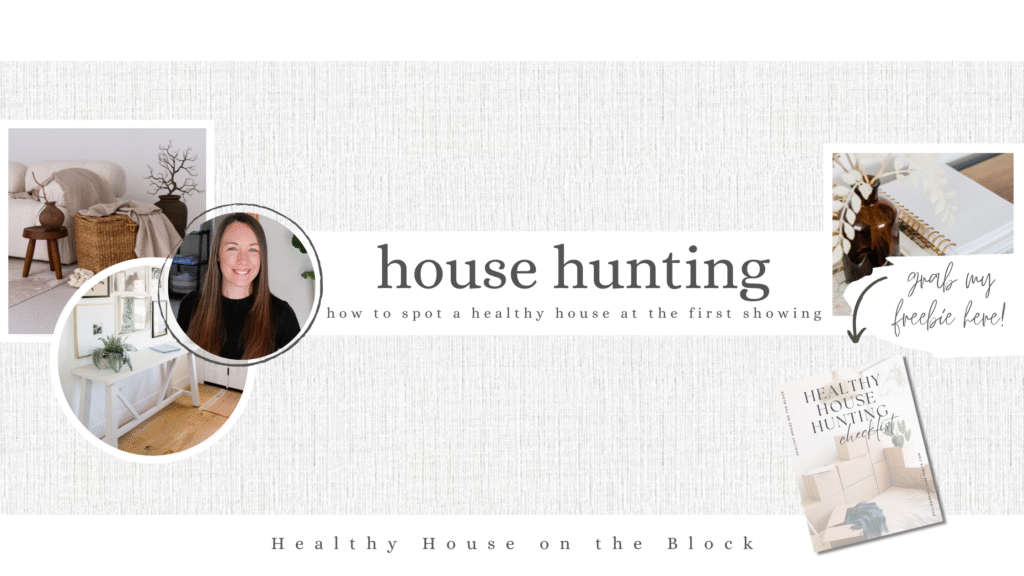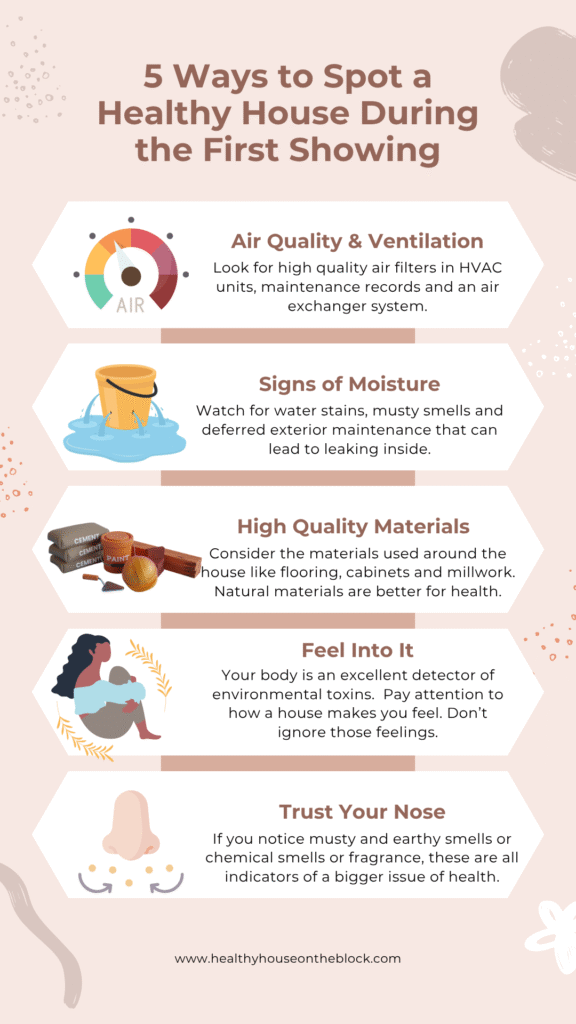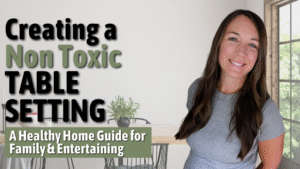
Finding the right home for your family goes beyond the perfect kitchen or dream backyard. As a building biology practitioner and certified home inspector, I’ve seen how the health of your home directly impacts the health of your family. The choices you make during house hunting can save you thousands in remediation costs later—and more importantly, protect your loved ones from hidden toxins that many homes harbor.
I know you’re already juggling so much as you search for your family’s next home. The last thing you need is another overwhelming checklist. That’s why I’m sharing the most essential health markers that any mom can spot during a showing, even without technical expertise. These are the same signs I look for when I evaluate homes professionally.
Why Your Home's Health Matters More Than Ever
Indoor air quality has become a serious concern for families. The EPA reports that indoor air can be 2–5 times more polluted than outdoor air, and we spend about 90% of our time indoors. Modern homes, while energy-efficient, often trap pollutants inside. From off-gassing building materials to hidden mold growth, the very place meant to protect your family can sometimes work against their health.
I’ve worked with countless families who moved into what seemed like perfect homes, only to discover respiratory issues, headaches, or unexplained fatigue that cleared up once we addressed hidden environmental toxins. The good news? Many of these issues are preventable when you know what to look for.

The Foundation of a Healthy Home: Air Quality and Ventilation
Fresh Air Exchange is Non-Negotiable
A healthy home breathes. This means air moves in, circulates, and moves out naturally. When you’re touring a home, pay attention to how the air feels. Does it feel fresh and circulating, or stuffy and stagnant?
Walk through each room and check that windows open easily and completely. Painted-shut windows are more common than you might think, especially in older homes. These create pockets of stagnant air that can harbor moisture and pollutants.
Look for cross-ventilation opportunities—windows or doors on opposite walls that allow air to flow through the space. This natural air exchange is especially important in bedrooms where your family spends 6-8 hours each night.
Kitchen and Bathroom Ventilation
These high-moisture areas need special attention. Check that bathroom fans are present and, if possible, ask if they vent outside rather than into the attic. Kitchen range hoods should also exhaust to the exterior. Poor ventilation in these areas leads to moisture buildup, which creates the perfect environment for mold growth.
HVAC System Health
While you may not be able to inspect the entire system during a showing, you can ask about its age and maintenance history. Look for clean air filters—dirty or cheap filters often indicate poor maintenance overall. If the home has a newer HVAC system, ask about whole-home ventilation features like HRV (Heat Recovery Ventilation) or ERV (Energy Recovery Ventilation) systems.

Water: Your Home's Biggest Health Risk and Greatest Asset
Understanding Water Damage Patterns
Water damage is the precursor to mold growth, and mold is one of the most serious indoor health threats families face. The key is learning to spot both obvious and subtle signs of moisture intrusion.
Start with the obvious: look for stains on ceilings, walls, and baseboards. Pay special attention to corners where two walls meet, as these are common areas for water to accumulate. Check around windows and doors for discoloration or soft spots that might indicate water penetration.
The Subtle Signs Most People Miss
Trust your nose. A musty or earthy smell, even if faint, often indicates mold growth that isn’t visible yet. This smell is particularly telling in basements, laundry rooms, and bathrooms. Don’t let pleasant air fresheners or candles mask your ability to detect these odors.
Look under sinks and around toilet bases for warped cabinets or soft flooring. These areas are prone to slow leaks that can cause significant damage over time. If possible, open closet doors and look behind large furniture pieces, as water damage is sometimes hidden in these areas.
Exterior Water Management
Step outside and evaluate how water moves around the foundation. The ground should slope away from the house on all sides. Downspouts should carry water at least 4-6 feet away from the foundation, with extensions or underground drainage systems in place.
Check gutters for proper function—they should be intact without visible overflow stains or damage. Look at the foundation walls for cracks, moss growth, or mineral staining, which can indicate ongoing moisture issues.

Building Materials: What Your Family Breathes Every Day
Flooring Considerations
Different flooring materials have vastly different impacts on indoor air quality. Vinyl and laminate flooring often contain phthalates and formaldehyde, which can off-gas for years after installation. Wall-to-wall carpeting, especially in bedrooms and basements, can trap dust, allergens, and even pesticides tracked in from outside.
Hardwood floors, natural stone, and ceramic tile generally present fewer air quality concerns, though you’ll want to ask about the adhesives and finishes used during installation.
Cabinet and Millwork Materials
Particleboard and MDF (medium-density fiberboard) cabinets can off-gas formaldehyde, particularly if they’re not properly sealed. Solid wood cabinets or those made with low-formaldehyde composite materials are healthier choices. If the home has particleboard cabinets, ask about their age—older installations have typically finished most of their off-gassing.
Paint and Finishes
Fresh paint smell isn’t just unpleasant—it can indicate ongoing VOC (Volatile Organic Compound) emissions. Ask about recent painting projects and whether low-VOC or zero-VOC paints were used. These details matter, especially in bedrooms and spaces where your family spends significant time.

Trusting Your Body's Wisdom
Physical Reactions as Health Indicators
Your body is an excellent detector of environmental toxins. Pay attention to how you feel during and after home tours. Headaches, fatigue, stuffy nose, or throat irritation can indicate poor air quality, even when a home appears clean and well-maintained.
If you find yourself feeling unwell in a particular home, don’t dismiss it. These reactions often indicate the presence of mold, VOCs, or other environmental triggers that standard home inspections might miss.
The “Clean” Smell Question
Be cautious of homes that smell artificially clean or heavily fragranced. Multiple plug-in air fresheners, candles, or diffusers throughout a home can indicate attempts to mask underlying odors. A truly healthy home should smell neutral or have a fresh, natural scent.
Questions to Ask During Your Tour
About the Home’s History
- Has the home ever experienced flooding or significant water damage?
- When was the HVAC system last serviced, and how old is it?
- Have there been any mold issues or remediation projects?
- When was the home last painted, and what type of paint was used?
About Recent Changes
- Have any flooring materials been replaced recently?
- Are there any ongoing moisture issues or leaks?
- What type of cleaning products are typically used in the home?

Making Health-Conscious Decisions
Prioritizing Your Family’s Needs
Remember that no home is perfect, and most issues can be addressed with the right knowledge and resources. The goal isn’t to find a flawless home, but to understand what you’re working with so you can make informed decisions about renovations, air quality improvements, and lifestyle adjustments.
Planning for the Future
Consider not just the home’s current state, but its potential for healthy improvements. Can windows be replaced for better ventilation? Are there opportunities to upgrade flooring or HVAC systems? Sometimes a home with good bones and minor issues is a better choice than a seemingly perfect home with hidden problems.
Moving Forward with Confidence
House hunting can feel overwhelming, especially when you’re trying to balance your family’s health needs with budget constraints and market pressures. Remember that your instincts matter. If something feels off about a home’s environment, trust that feeling and investigate further.
The most important thing is that you’re already thinking about these factors. Many families never consider the health implications of their home environment until problems arise. By incorporating these considerations into your house hunting process, you’re taking a proactive step toward creating a healthier space for your family.
Take your time, ask questions, and remember that the right home for your family is one that supports both your lifestyle and your health. You have the knowledge to make informed decisions, and you deserve a home environment that helps your family thrive.
Share this:
- Click to share on Facebook (Opens in new window) Facebook
- Click to share on LinkedIn (Opens in new window) LinkedIn
- Click to share on Reddit (Opens in new window) Reddit
- Click to share on Pinterest (Opens in new window) Pinterest
- Click to print (Opens in new window) Print
- Click to share on X (Opens in new window) X




